4WD FORD F150 1998 10.G Owners Manual
[x] Cancel search | Manufacturer: FORD, Model Year: 1998, Model line: F150, Model: FORD F150 1998 10.GPages: 219, PDF Size: 1.49 MB
Page 3 of 219

contents without notice and
without incurring obligation.
SPECIAL NOTICES
Using your vehicle with a
snowplow
For more information and
guidelines for using your vehicle
with a snowplow, refer to the
Drivingchapter.
Using your vehicle as an
ambulance
Do not use this vehicle as
an ambulance.
Your vehicle is not equipped with
the Ford Ambulance Preparation
package.
Notice to owners of utility type
vehicles
Before you drive your vehicle,
please read this Owner's Guide
carefully. Your vehicle is not a
passenger car. As with other
vehicles of this type, failure to
operate this vehicle correctly may
result in loss of control or an
accident.
Be sure to readDriving off road
in theDrivingchapter as well as
the ªFour Wheelingº supplement
included with 4WD and utility type
vehicles.
Introduction
3
Page 5 of 219
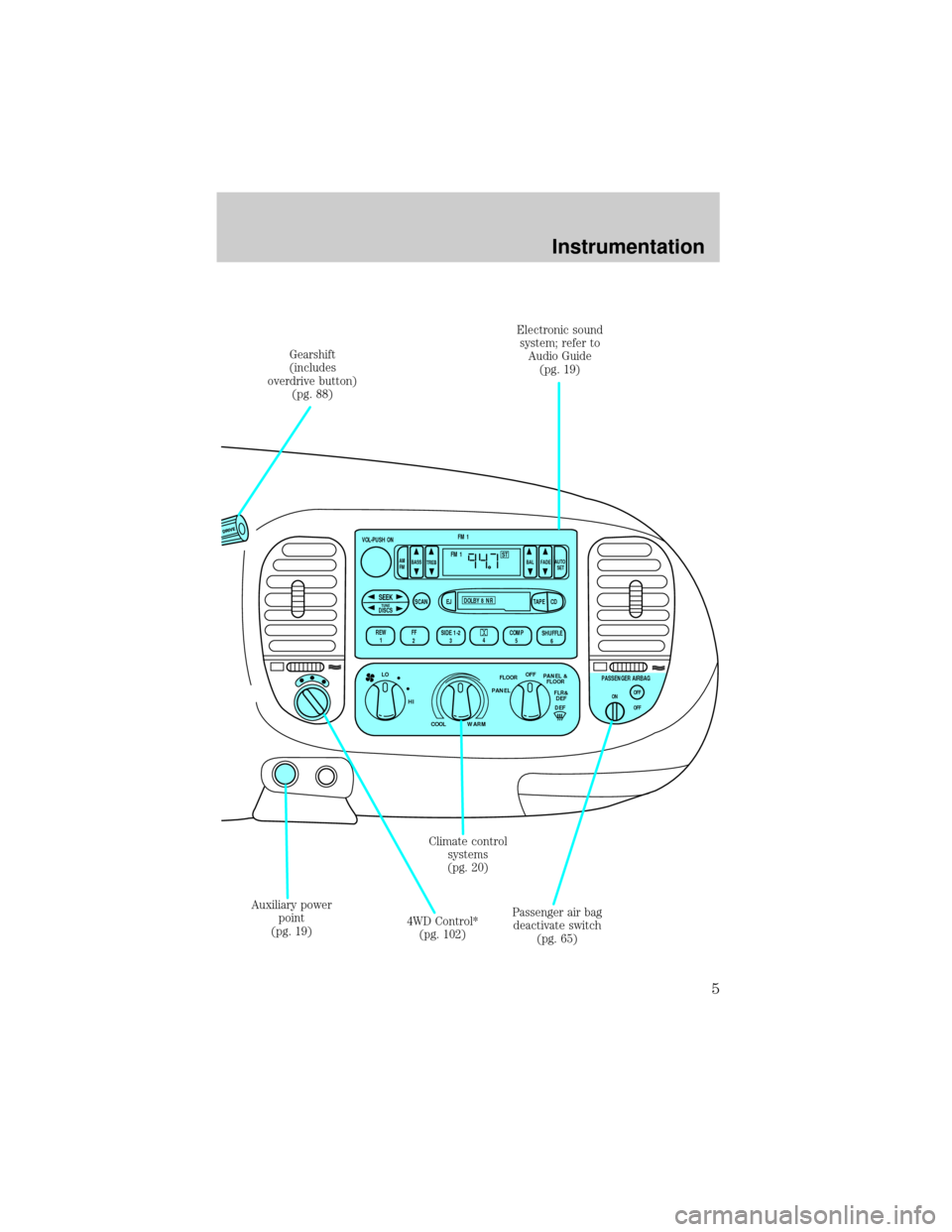
VOL-PUSH ON
AM
FMBASS
TREBBAL FADEAUTO
SET
SEEKTUNEDISCSSCAN EJTAPE
CDDOLBY 8 NR
REW
1FF
2SIDE 1-2
34COMP
5SHUFFLE
6
ST FM 1
FM 1
FLOOR
PANELLO
HI
COOL WARMDEF FLR&
DEF PANEL &
FLOOR OFF
PASSENGER AIRBAGOFF
OFF ON
Passenger air bag
deactivate switch
(pg. 65) Climate control
systems
(pg. 20) Gearshift
(includes
overdrive button)
(pg. 88)
Auxiliary power
point
(pg. 19)4WD Control*
(pg. 102)Electronic sound
system; refer to
Audio Guide
(pg. 19)
Instrumentation
5
Page 19 of 219

²A small LED illuminates next to
the autolamp control to indicate
that the headlamps have been
turned on by the autolamps.
²Foglamps are not controlled by
the autolamps. In order to turn
on the foglamps, you must turn
the lamp switch to the
position and pull for fog.
4WD CONTROL (IF EQUIPPED)
This control operates the 4WD.
Refer toFour-wheel drive (4WD)
operationin theDrivingchapter
for more information.
AUXILIARY POWER POINT
The auxiliary power point is
located on the instrument panel.
Do not plug optional electrical
accessories into the cigarette
lighter. Use the powerpoint.
AUDIO SYSTEM
Refer to the ªAudio Guideº for
instructions on how to operate the
audio system.
4H
2H
4L
Controls and features
19
Page 60 of 219
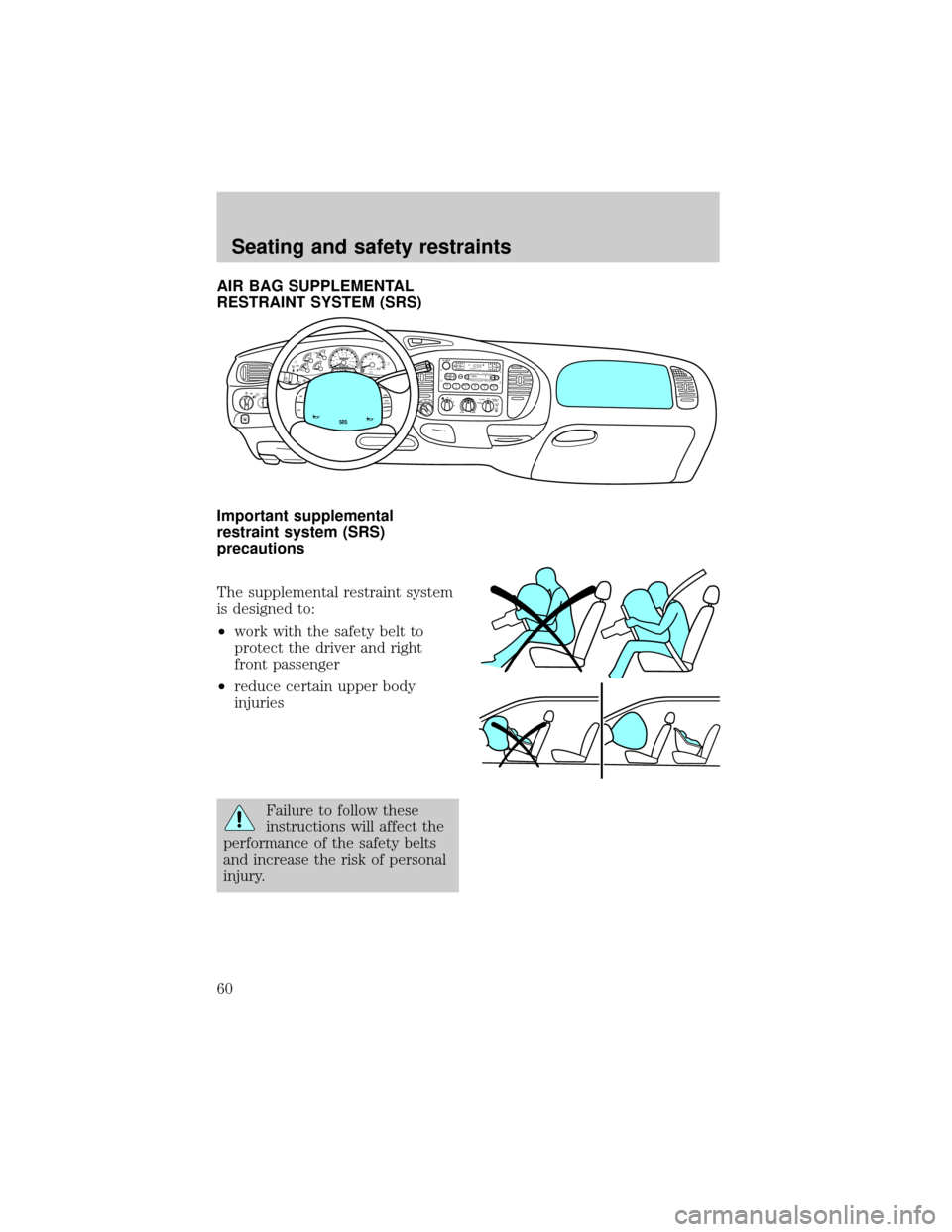
AIR BAG SUPPLEMENTAL
RESTRAINT SYSTEM (SRS)
Important supplemental
restraint system (SRS)
precautions
The supplemental restraint system
is designed to:
²work with the safety belt to
protect the driver and right
front passenger
²reduce certain upper body
injuries
Failure to follow these
instructions will affect the
performance of the safety belts
and increase the risk of personal
injury.
FOR
SCANEJ
REWFF SIDE 1-2COMPSHUFFLETAPECDDISCSBASS TREBBAL FADEAUTO
SETVOL - PUSH ONSEEKTUNEAM
FM
12 3456fwDOLBY B NRFM1STDOOR
AJAR
BRAKEF
E
H H
18
820
10304050
60
70
80
90
10020 406080
100
120
140
160
MPH km/h00000000
012PRN 21RPMx1000CHECK
ENGINE THEFT3
4
5
6CHECK
SUSPLOW
FUEL
ABS
PPULL
FOGPANEL
DIM4H
A4WD4L
OVERDRIVE
SRS
ON
OFFRES
SET
ACCELCOASTFLOOR
PANELLO
HICOOL WARMDEF FLR&
DEF PANEL &
FLOOR OFF
Seating and safety restraints
60
Page 95 of 219

Upshifts when accelerating (recommended for best fuel
economy)
2 - 3 32 km/h (20 mph) 11 km/h (7 mph)
3 - 4 50 km/h (31 mph) 19 km/h (12 mph)
4-
D(Overdrive)71 km/h (44 mph) 27 km/h (17 mph)
Upshifts when cruising (recommended for best fuel economy)
Shift from: Transfer case position (if equipped)
2H or 4H 4L
1 - 2 16 km/h (10 mph) 6 km/h (4 mph)
2 - 3 26 km/h (16 mph) 10 km/h (6 mph)
3 - 4 43 km/h (27 mph) 16 km/h (10 mph)
4-
D(Overdrive)68 km/h (42 mph) 26 km/h (16 mph)
Maximum downshift speeds
Shift from: Transfer case position (if equipped)
2H or 4H 4L
D(Overdrive) -
488 km/h (55 mph) 34 km/h (21 mph)
4 - 3 72 km/h (45 mph) 27 km/h (17 mph)
3 - 2 56 km/h (35 mph) 21 km/h (13 mph)
2 - 1 32 km/h (20 mph) 11 km/h (7 mph)
Use 2H or 4H for 4WD equipped vehicles. Downshift at lower speeds
when driving on slippery surfaces.
Driving
95
Page 98 of 219
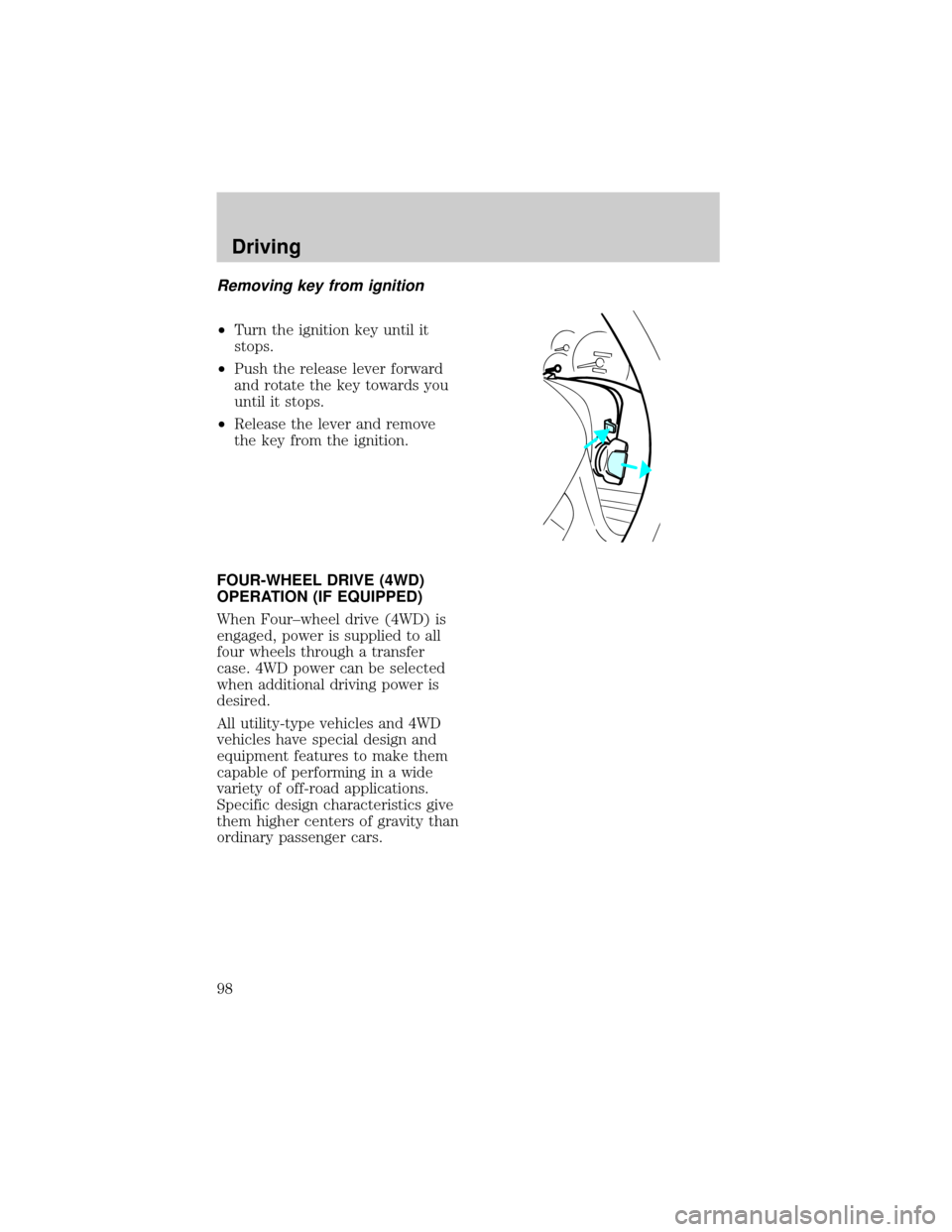
Removing key from ignition
²Turn the ignition key until it
stops.
²Push the release lever forward
and rotate the key towards you
until it stops.
²Release the lever and remove
the key from the ignition.
FOUR-WHEEL DRIVE (4WD)
OPERATION (IF EQUIPPED)
When Four±wheel drive (4WD) is
engaged, power is supplied to all
four wheels through a transfer
case. 4WD power can be selected
when additional driving power is
desired.
All utility-type vehicles and 4WD
vehicles have special design and
equipment features to make them
capable of performing in a wide
variety of off-road applications.
Specific design characteristics give
them higher centers of gravity than
ordinary passenger cars.
Driving
98
Page 99 of 219
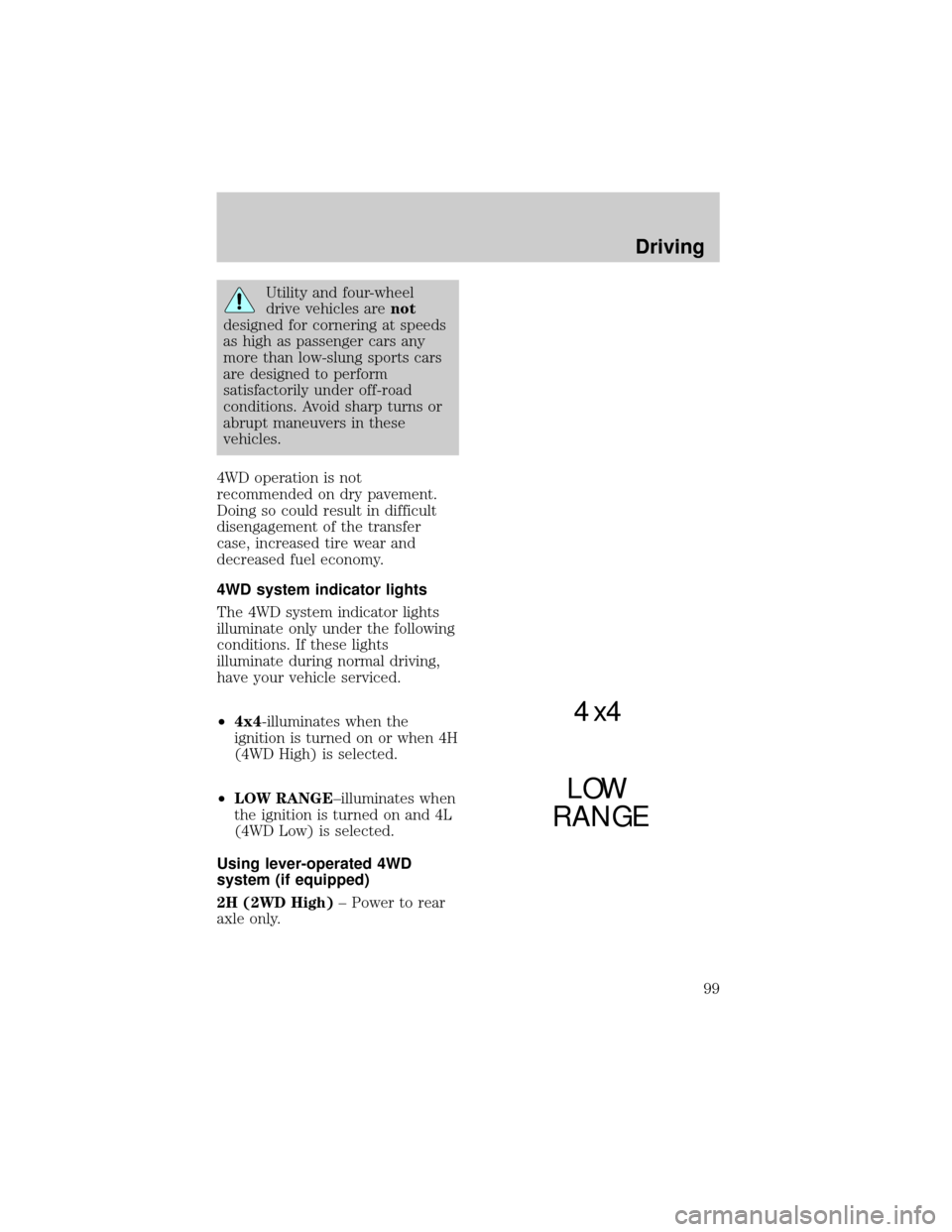
Utility and four-wheel
drive vehicles arenot
designed for cornering at speeds
as high as passenger cars any
more than low-slung sports cars
are designed to perform
satisfactorily under off-road
conditions. Avoid sharp turns or
abrupt maneuvers in these
vehicles.
4WD operation is not
recommended on dry pavement.
Doing so could result in difficult
disengagement of the transfer
case, increased tire wear and
decreased fuel economy.
4WD system indicator lights
The 4WD system indicator lights
illuminate only under the following
conditions. If these lights
illuminate during normal driving,
have your vehicle serviced.
²4x4-illuminates when the
ignition is turned on or when 4H
(4WD High) is selected.
²LOW RANGE±illuminates when
the ignition is turned on and 4L
(4WD Low) is selected.
Using lever-operated 4WD
system (if equipped)
2H (2WD High)± Power to rear
axle only.
4x4
LOW
RANGE
Driving
99
Page 100 of 219
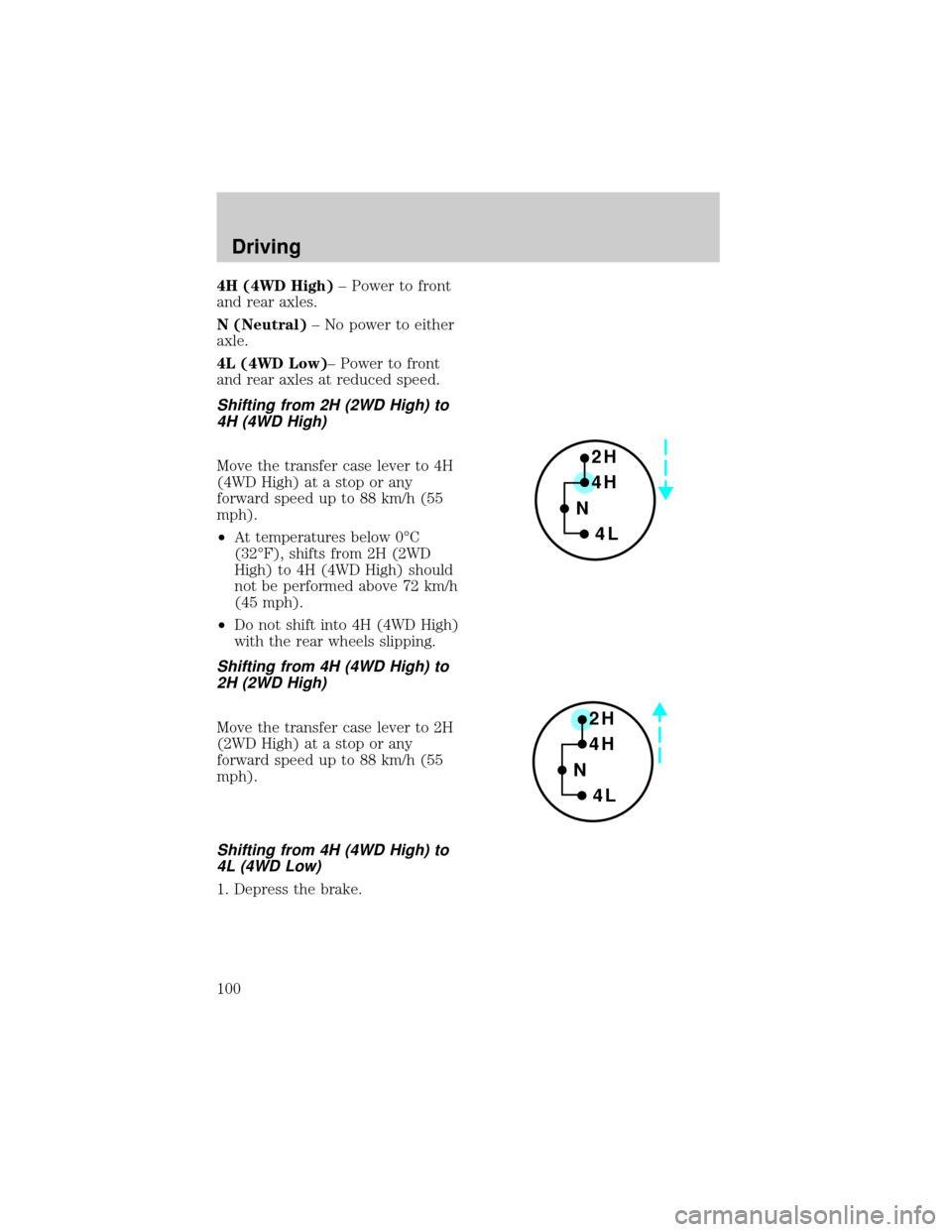
4H (4WD High)± Power to front
and rear axles.
N (Neutral)± No power to either
axle.
4L (4WD Low)± Power to front
and rear axles at reduced speed.
Shifting from 2H (2WD High) to
4H (4WD High)
Move the transfer case lever to 4H
(4WD High) at a stop or any
forward speed up to 88 km/h (55
mph).
²At temperatures below 0ÉC
(32ÉF), shifts from 2H (2WD
High) to 4H (4WD High) should
not be performed above 72 km/h
(45 mph).
²Do not shift into 4H (4WD High)
with the rear wheels slipping.
Shifting from 4H (4WD High) to
2H (2WD High)
Move the transfer case lever to 2H
(2WD High) at a stop or any
forward speed up to 88 km/h (55
mph).
Shifting from 4H (4WD High) to
4L (4WD Low)
1. Depress the brake.
2H
4H
4L N
2H
4H
4L N
Driving
100
Page 101 of 219
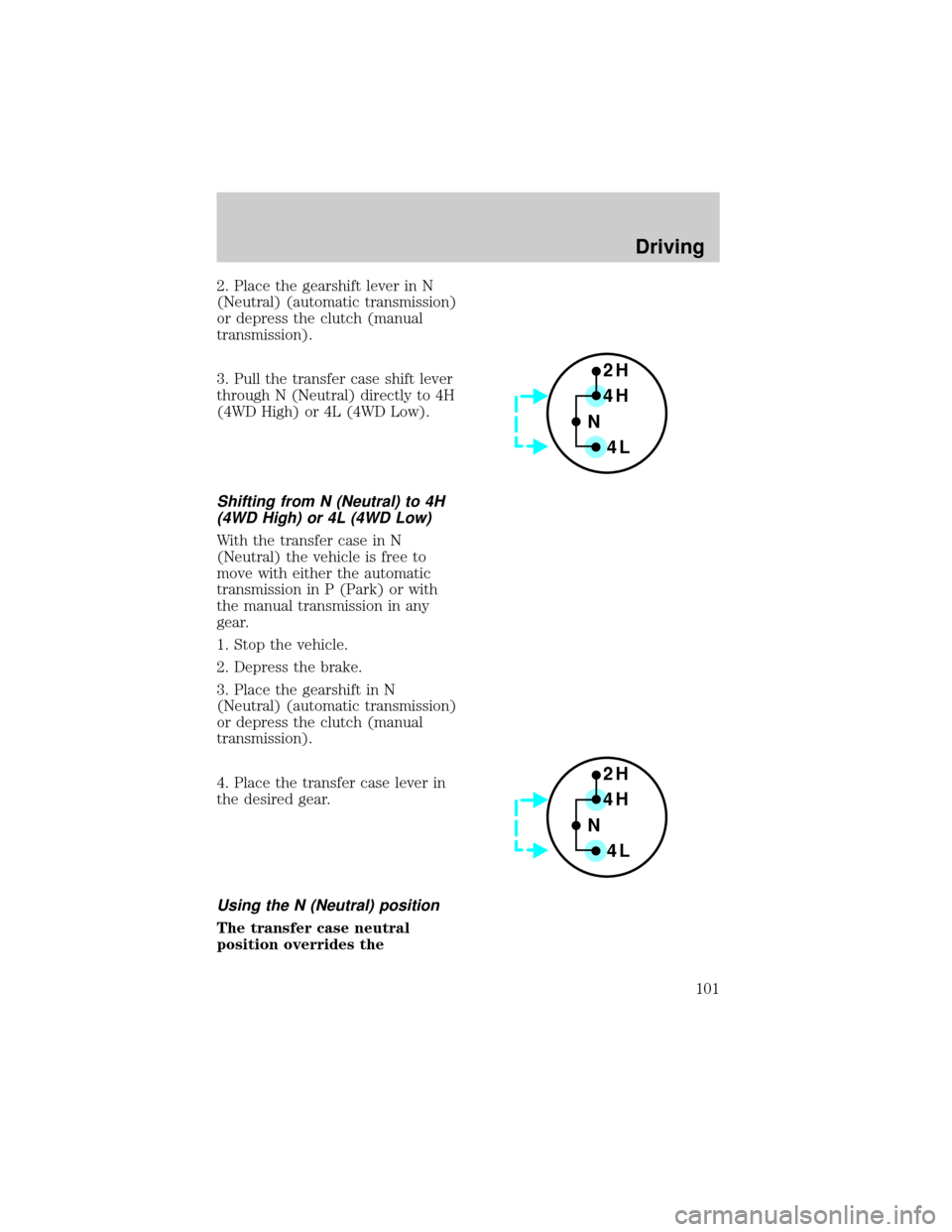
2. Place the gearshift lever in N
(Neutral) (automatic transmission)
or depress the clutch (manual
transmission).
3. Pull the transfer case shift lever
through N (Neutral) directly to 4H
(4WD High) or 4L (4WD Low).
Shifting from N (Neutral) to 4H
(4WD High) or 4L (4WD Low)
With the transfer case in N
(Neutral) the vehicle is free to
move with either the automatic
transmission in P (Park) or with
the manual transmission in any
gear.
1. Stop the vehicle.
2. Depress the brake.
3. Place the gearshift in N
(Neutral) (automatic transmission)
or depress the clutch (manual
transmission).
4. Place the transfer case lever in
the desired gear.
Using the N (Neutral) position
The transfer case neutral
position overrides the
2H
4H
4L N
2H
4H
4L N
Driving
101
Page 102 of 219
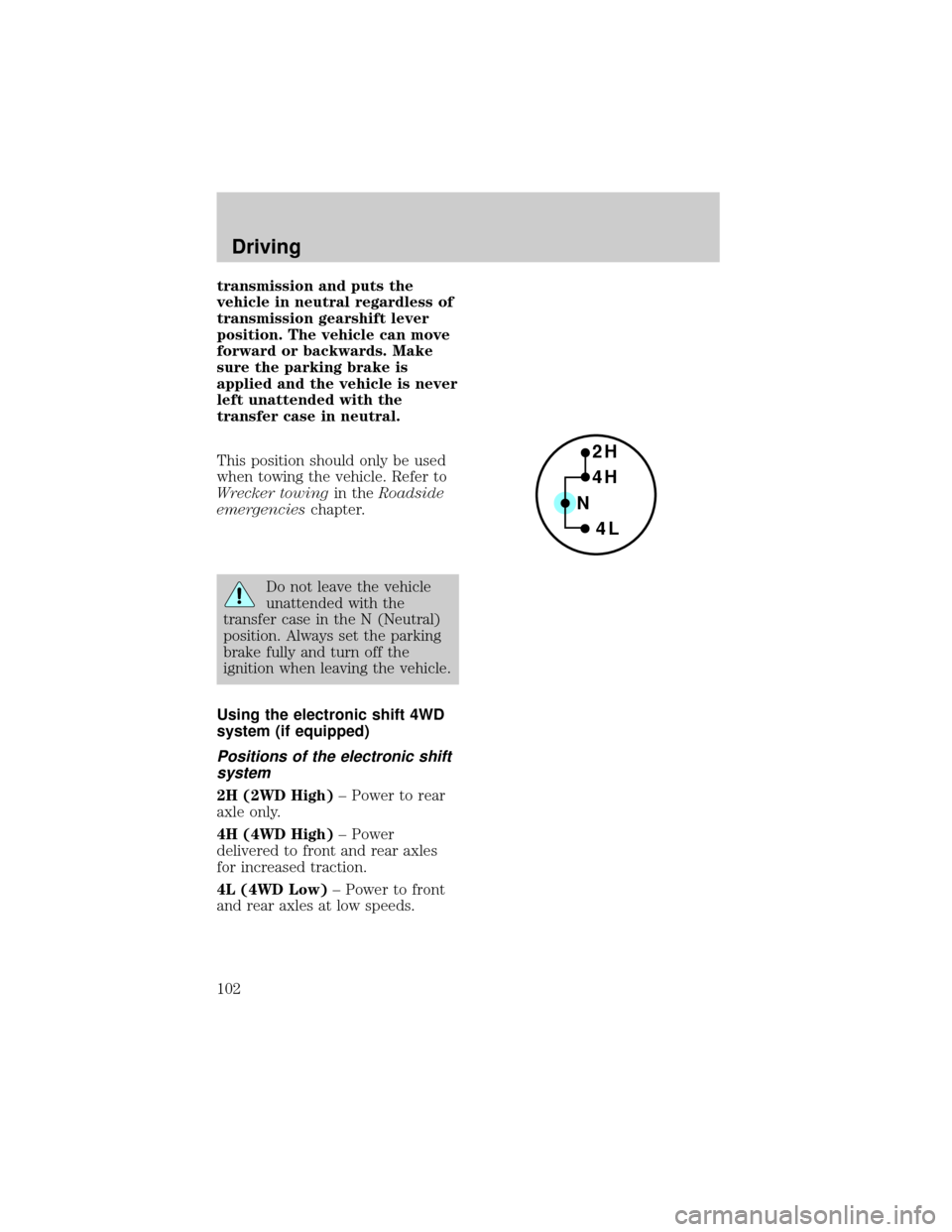
transmission and puts the
vehicle in neutral regardless of
transmission gearshift lever
position. The vehicle can move
forward or backwards. Make
sure the parking brake is
applied and the vehicle is never
left unattended with the
transfer case in neutral.
This position should only be used
when towing the vehicle. Refer to
Wrecker towingin theRoadside
emergencieschapter.
Do not leave the vehicle
unattended with the
transfer case in the N (Neutral)
position. Always set the parking
brake fully and turn off the
ignition when leaving the vehicle.
Using the electronic shift 4WD
system (if equipped)
Positions of the electronic shift
system
2H (2WD High)± Power to rear
axle only.
4H (4WD High)± Power
delivered to front and rear axles
for increased traction.
4L (4WD Low)± Power to front
and rear axles at low speeds.
2H
4H
4L N
Driving
102